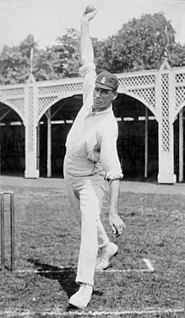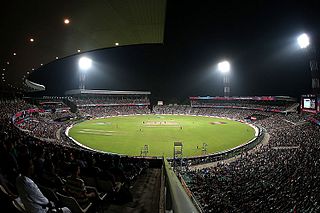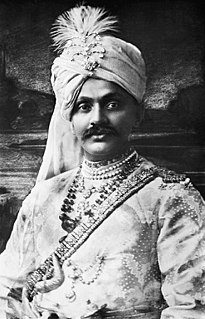
James Charles Laker was an English cricketer who played for Surrey County Cricket Club (Surrey) from 1946 to 1959 and represented England in 46 test matches. He was born in Shipley and died in Putney.

Sir John Berry Hobbs, always known as Jack Hobbs, was an English professional cricketer who played for Surrey from 1905 to 1934 and for England in 61 Test matches between 1908 and 1930.

Frederick Sewards Trueman, OBE was an English cricketer, mainly active from 1948 to 1968, who played for Yorkshire and England. He had professional status and later became a popular author and broadcaster. He was born in Stainton, West Riding of Yorkshire, and died in Steeton with Eastburn, West Yorkshire. He appeared in 603 first-class matches, including 67 Test matches, as a right-handed batsman who bowled right arm fast.

Leslie Thomas John Arlott, OBE was an English journalist, author and cricket commentator for the BBC's Test Match Special. He was also a poet and wine connoisseur. With his poetic phraseology, he became a cricket commentator noted for his "wonderful gift for evoking cricketing moments" by the BBC.

Sydney Francis Barnes was an English professional cricketer who is generally regarded as one of the greatest ever bowlers. He was right-handed and bowled at a pace that varied from medium to fast-medium with the ability to make the ball both swing and break from off or leg. In Test cricket, Barnes played for England in 27 matches from 1901 to 1914, taking 189 wickets at 16.43, one of the lowest Test bowling averages ever achieved. In 1911–12, he helped England to win the Ashes when he took 34 wickets in the series against Australia. In 1913–14, his final Test series, he took a world series record 49 wickets against South Africa.
William Howard "Bill" Frindall, was an English cricket scorer and statistician. He was familiar to cricket followers as a member of the Test Match Special commentary team on BBC radio. Nicknamed the Bearded Wonder by Brian Johnston for his ability to research the most obscure cricketing facts in moments, while continuing to keep perfect scorecards and because he had a beard. Angus Fraser described Frindall as "the doyen of cricket scorers" in his obituary in The Independent.
The Hambledon Club was a social club that is famous for its organisation of 18th century cricket matches. By the late 1770s it was the foremost cricket club in England.

William Caffyn, known as Billy Caffyn, was an English cricketer who played mainly for Surrey County Cricket Club and various England representative sides. Caffyn was born in Reigate in Surrey in 1828 and died in 1919 aged 91 in the town. He made five appearances for New South Wales, two for Kent and one for Lancashire as well as appearing five times for Marylebone Cricket Club.
The sport of cricket has long held a special place in Anglophone culture, and a specialised niche in English literature. Cricket is the official summer sport in England, and it is widely known as the "gentleman's game", owing to the unique culture of the sport and its emphasis on ideals such as grace, sportsmanship, character and complexity. Cricket has therefore often attracted the attention of the literati – Lamb, Hazlitt and Leigh Hunt were all players of the game – and some of the greatest English writers have written about cricket. This was particularly true in the era before the Second World War, for example, during the Edwardian era, and in the 1920s and 1930s.
George Bent Buckley was an English surgeon and a celebrated cricket historian and an authority on the early days of the game.
Richard Ingleby Jefferson was a professional cricketer who played for Surrey County Cricket Club.
Major Rowland Francis Bowen was a cricket researcher, historian and writer.
The Professional Cricketers' Association is the representative body of past and present first-class cricketers in England and Wales, founded in 1967 by former England fast bowler Fred Rumsey. In the 1970s, the PCA arranged a standard employment contract and minimum wage for professional cricketers in first-class cricket in England and Wales.
Alresford Cricket Club was one of the strongest cricket teams in England during the late 18th century. It represented the adjacent small towns of New Alresford and Old Alresford in Hampshire. According to John Arlott, between about 1770 and 1795 Alresford "stood higher in cricket than any town its size has done in the history of the game".

P'tang, Yang, Kipperbang, also released as Kipperbang, is a British television film first shown on Channel 4 on its second night, 3 November 1982.

Mervyn Derek Burden was an English cricketer. Burden was a right-arm off break bowler and a right-handed tail-end batsman.
Margaret Patricia Hughes was a sportswriter.
The Cricketers of My Time is a memoir of cricket, nominally written by the former Hambledon cricketer John Nyren about the players of the late 18th century, most of whom he knew personally. Nyren, who had no recognised literary skill, collaborated with the eminent Shakespearean scholar Charles Cowden Clarke to produce his work. It is believed that Cowden Clarke recorded Nyren's verbal reminiscences and so "ghosted" the text.
David Rayvern Allen was a cricket writer and historian, as well as a radio producer and presenter, a speaker and a musician. His radio productions won awards including the 1991 Prix Italia for Who Pays the Piper, a collaboration with Richard Stilgoe. He died aged 76 in 2014.
Edward McQueen Rose is a former cricketer who played first-class cricket for Cambridge University from 1958 to 1960.










